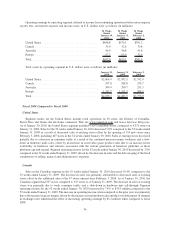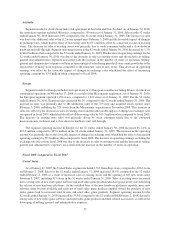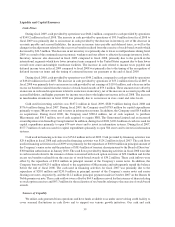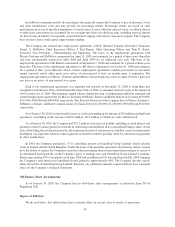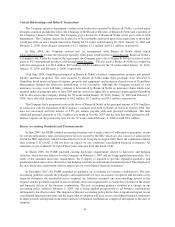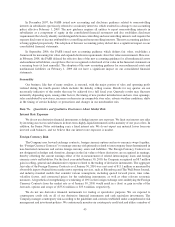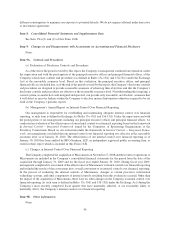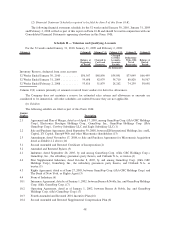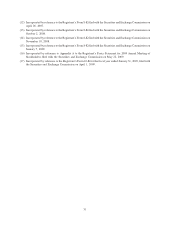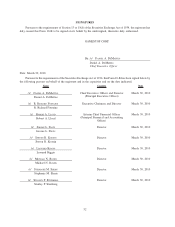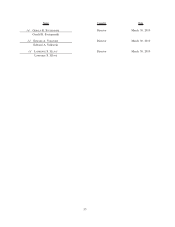GameStop 2009 Annual Report Download - page 60
Download and view the complete annual report
Please find page 60 of the 2009 GameStop annual report below. You can navigate through the pages in the report by either clicking on the pages listed below, or by using the keyword search tool below to find specific information within the annual report.In December 2007, the FASB issued new accounting and disclosure guidance related to noncontrolling
interests in subsidiaries (previously referred to as minority interests), which resulted in a change to our accounting
policy effective February 1, 2009. The new guidance requires all entities to report noncontrolling interests in
subsidiaries as a component of equity in the consolidated financial statements and also establishes disclosure
requirements that clearly identify and distinguish between controlling and noncontrolling interests and requires the
separate disclosure of income attributable to controlling and noncontrolling interests. The new accounting guidance
is being applied prospectively. The adoption of this new accounting policy did not have a significant impact on our
consolidated financial statements.
In September 2006, the FASB issued new accounting guidance which defines fair value, establishes a
framework for measuring fair value and expands disclosure requirements about fair value measurements. However,
in February 2008, the FASB delayed the effective date of the new accounting guidance for all nonfinancial assets
and nonfinancial liabilities, except those that are recognized or disclosed at fair value in the financial statements on
a recurring basis (at least annually). The adoption of this new accounting guidance for our nonfinancial assets and
nonfinancial liabilities on February 1, 2009 did not have a significant impact on our consolidated financial
statements.
Seasonality
Our business, like that of many retailers, is seasonal, with the major portion of sales and operating profit
realized during the fourth quarter which includes the holiday selling season. Results for any quarter are not
necessarily indicative of the results that may be achieved for a full fiscal year. Quarterly results may fluctuate
materially depending upon, among other factors, the timing of new product introductions and new store openings,
sales contributed by new stores, increases or decreases in comparable store sales, adverse weather conditions, shifts
in the timing of certain holidays or promotions and changes in our merchandise mix.
Item 7A. Quantitative and Qualitative Disclosures About Market Risk
Interest Rate Exposure
We do not use derivative financial instruments to hedge interest rate exposure. We limit our interest rate risks
by investing our excess cash balances in short-term, highly-liquid instruments with a maturity of one year or less. In
addition, the Senior Notes outstanding carry a fixed interest rate. We do not expect any material losses from our
invested cash balances, and we believe that our interest rate exposure is modest.
Foreign Currency Risk
The Company uses forward exchange contracts, foreign currency options and cross-currency swaps (together,
the “Foreign Currency Contracts”) to manage currency risk primarily related to intercompany loans denominated in
non-functional currencies and certain foreign currency assets and liabilities. The Foreign Currency Contracts are
not designated as hedges and, therefore, changes in the fair values of these derivatives are recognized in earnings,
thereby offsetting the current earnings effect of the re-measurement of related intercompany loans and foreign
currency assets and liabilities. For the fiscal year ended January 30, 2010, the Company recognized an $8.7 million
gain in selling, general and administrative expenses related to the trading of derivative instruments. The aggregate
fair value of the Foreign Currency Contracts as of January 30, 2010 was a net asset of $11.1 million as measured by
observable inputs obtained from market news reporting services, such as Bloomberg and The Wall Street Journal,
and industry-standard models that consider various assumptions, including quoted forward prices, time value,
volatility factors, and contractual prices for the underlying instruments, as well as other relevant economic
measures. A hypothetical strengthening or weakening of 10% in the foreign exchange rates underlying the Foreign
Currency Contracts from the market rate as of January 30, 2010 would result in a (loss) or gain in value of the
forwards, options and swaps of ($35.6) million or $35.6 million, respectively.
We do not use derivative financial instruments for trading or speculative purposes. We are exposed to
counterparty credit risk on all of our derivative financial instruments and cash equivalent investments. The
Company manages counterparty risk according to the guidelines and controls established under comprehensive risk
management and investment policies. We continuously monitor our counterparty credit risk and utilize a number of
45



